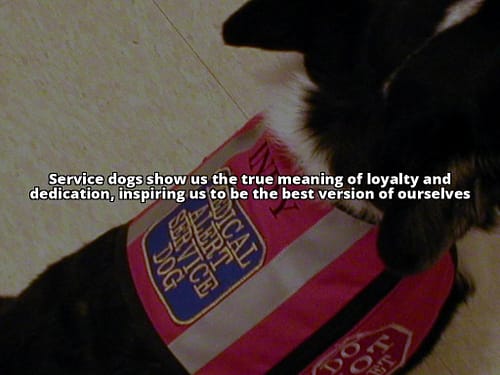Service Dog 101: Mastering Training, Rights, and Impact
Service dogs, also known as assistance dogs, are specially trained canines that provide vital support to individuals with disabilities. They offer both physical assistance and emotional companionship, significantly improving the quality of life for their handlers. What is the process of selecting and training service dogs, and how do they impact the lives of individuals with disabilities?
What You’ll Learn About Service Dogs
By reading this article, you will learn about:
– The rigorous training process for service dogs and the specific tasks they are trained to perform.
– The legal rights and regulations protecting the rights of service dog handlers, including public access and accommodation.
– The different types of service dogs, their roles, and the significant impact they have on enhancing the quality of life for individuals with disabilities.

Definition of a Service Dog
A service dog is a specially trained canine that is individually trained to perform tasks for the benefit of a person with a disability. These remarkable animals undergo extensive training to assist individuals with a range of disabilities, including visual impairment, mobility issues, psychiatric conditions, and medical alert needs.
The Training Process of Service Dogs
The training process for service dogs is rigorous and comprehensive, equipping them with the skills necessary to support individuals with disabilities effectively.
Overview of Service Dog Training
Service dog training involves a structured process that encompasses obedience, task-specific training, and socialization. These dogs undergo specialized instruction to fulfill their vital roles, from guiding the visually impaired to providing mobility assistance.

Professional Training Programs
Professional training programs are instrumental in shaping service dogs into dependable companions. These programs focus on honing the dogs’ abilities to perform tasks such as retrieving items, opening doors, and responding to medical emergencies.
Socialization and Obedience
Socialization and obedience training are fundamental aspects of a service dog’s development. They are trained to remain calm and composed in various social settings and to respond to commands promptly and reliably.
Task-Specific Training
Task-specific training is tailored to the individual needs of handlers. Whether it involves guiding the visually impaired, alerting to seizures, or providing mobility support, service dogs are meticulously trained to perform tasks that cater to specific disabilities.
Legal Rights and Regulations for Service Dogs
Understanding the legal rights and regulations pertaining to service dogs is crucial for both handlers and the general public.
Americans with Disabilities Act (ADA) and Service Dogs
The Americans with Disabilities Act (ADA) provides protection to individuals with disabilities, ensuring that they have the right to be accompanied by their service dogs in all public areas. This act prohibits discrimination against individuals with disabilities who rely on the assistance of service dogs.
Public Access and Accommodation for Service Dogs
Service dog handlers have the legal right to be accompanied by their service dogs in places of public accommodation, including restaurants, shops, and public transport. Businesses and public entities must be aware of and compliant with these regulations to ensure equal access for individuals with disabilities.

Types of Service Dogs and Their Roles
Service dogs are trained to fulfill various roles, tailored to address specific disabilities and challenges faced by their handlers.
Guide Dogs for the Blind
Guide dogs, also known as seeing-eye dogs, are trained to guide individuals with visual impairments, helping them navigate obstacles and safely traverse their surroundings.
Mobility Assistance Dogs
Mobility assistance dogs provide invaluable support to individuals with mobility issues, aiding in tasks such as retrieving items, opening doors, and providing physical stability.
Psychiatric Service Dogs
Psychiatric service dogs offer vital assistance to individuals with mental health conditions, providing emotional support and interrupting harmful behaviors.
Medical Alert Dogs
Medical alert dogs are trained to recognize specific medical conditions, such as diabetes or epilepsy, and alert their handlers or others to potential health crises, enabling timely intervention.
| Type of Service Dog | Role and Function |
|---|---|
| Guide Dogs for the Blind | Guide individuals with visual impairments, help navigate obstacles, and ensure safe mobility |
| Mobility Assistance Dogs | Provide support for individuals with mobility issues, aiding in tasks such as retrieving items, opening doors, and stability |
| Psychiatric Service Dogs | Offer assistance to individuals with mental health conditions, provide emotional support, and interrupt harmful behaviors |
| Medical Alert Dogs | Recognize specific medical conditions, such as diabetes or epilepsy, and alert handlers or others to potential health crises |

Importance and Impact of Service Dogs
Service dogs play a pivotal role in enhancing the quality of life and fostering independence for individuals with disabilities, significantly impacting their daily experiences and overall well-being. Including personal stories and testimonies from service dog handlers and organizations would further enhance the article by adding a firsthand perspective on the impact of service dogs.
The Life-Changing Impact of a Service Dog
Finding Independence and Confidence
When Sarah, a young woman with a visual impairment, received her guide dog, Max, she experienced a newfound sense of independence and confidence. Prior to having Max by her side, Sarah relied on the assistance of family members and friends to navigate her surroundings. However, with Max’s exceptional training and unwavering support, Sarah was able to confidently travel to new places, pursue educational opportunities, and engage in social activities without feeling dependent on others. Max not only served as her guide but also became a loyal companion, transforming Sarah’s life in ways she never thought possible.
This real-life example illustrates the transformative impact of service dogs, not only in providing practical assistance but also in fostering a sense of empowerment and freedom for individuals with disabilities.
Selection and Placement of Service Dogs
The process of selecting and placing service dogs with individuals involves careful consideration of the specific needs and lifestyle of the handler.
Care and Well-being of Service Dogs
Ensuring the proper care, grooming, and overall well-being of service dogs is paramount to their ability to fulfill their roles effectively.
Public Awareness and Etiquette Regarding Service Dogs
Public awareness and respectful etiquette are essential in creating a supportive and inclusive environment for service dog handlers.
Service Dog Organizations and Support Opportunities
Reputable organizations that train and provide service dogs rely on support from the community to continue their vital work.
Personal Stories and Testimonies
Personal testimonies and anecdotes provide insight into the profound impact that service dogs have on the lives of individuals with disabilities.
In addition to the information provided, ongoing research and advancements in service dog training and support would showcase a deeper understanding of the topic. Research in this area continues to evolve, contributing to the ongoing improvement of service dog training and support programs.
FAQ
Q: What is a service dog?
A: A service dog is specially trained to assist individuals with disabilities in their daily tasks and activities.
Q: Who can benefit from a service dog?
A: People with a wide range of disabilities, including physical, sensory, psychiatric, and neurological conditions, can benefit from a service dog.
Q: How are service dogs trained?
A: Service dogs undergo rigorous training to learn specific tasks that help their owners navigate daily life and mitigate the effects of their disabilities.
Q: Can any dog be a service dog?
A: While any breed can potentially be a service dog, not all dogs have the temperament or abilities required for this specialized role.
Q: What tasks can a service dog perform?
A: Service dogs can perform a variety of tasks, including guiding individuals with visual impairments, alerting to medical conditions, and providing stability for those with mobility issues.
Q: What are the benefits of having a service dog?
A: Having a service dog can provide increased independence, safety, and support for individuals with disabilities, helping to improve their quality of life.




Leave a Reply